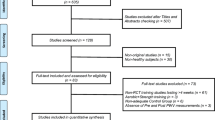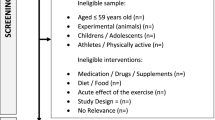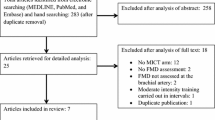Abstract
Background
Arterial stiffness (AS) is a key measure in predicting risk for cardiovascular disease (CVD) and related events, independent of other risk factors. Resistance training (RT) has been shown to increase AS in young healthy subjects. However, the effects of RT on AS in persons with or at risk for CVD remain unclear; this uncertainty is a barrier to RT prescription in this population. Considering RT may be as effective as or superior to aerobic exercise prescription in treating some co-morbidities associated with CVD, it would be helpful to clarify whether RT does lead to clinically meaningful increases (detrimental) in AS in those with CVD or CVD risk factors.
Objectives
The aim of this study was to (1) assess the effects of RT on measures of AS in at-risk populations, and (2) discuss the implications of the findings for clinical exercise physiologists.
Data Sources
The electronic databases PubMed, Web of Science, SPORTDiscus, and Google Scholar were searched from inception to February 2018. The reference lists of eligible articles and reviews were also checked.
Study Selection
Inclusion criteria were: (1) the trial was a randomized controlled trial; (2) exercise prescription of RT or a combination of resistance and aerobic exercise for at least 8 weeks; (3) control group characteristics allowed for comparison of the main effects of the exercise prescription; (4) subjects had known CVD or a risk factor associated with CVD according to the American College of Sports Medicine (ACSM) guidelines; (5) article measured at least carotid to femoral pulse wave velocity (PWV) or augmentation index (AIx).
Appraisal and Synthesis Methods
Initially, 1427 articles were identified. After evaluation of study characteristics, quality and validity data from 12 articles and 13 cohorts involving 651 participants (223 women, 338 men, 90 unknown) were extracted for the meta-analysis. To enable comparisons between assessments, and to infer clinical significance, standardized mean differences (SMD) were calculated. When data were not available, values were estimated according to Cochrane guidelines.
Results
According to the JADAD scale, the mean quality of studies was 3 out of 5. The duration of the included studies ranged from 8 weeks to 24 months. RT trended towards decreasing (improving) PWV (SMD = − 0.168, 95% CI − 0.854 to 0.152, p = 0.057). There were no significant differences in AIx (SMD = − 0.286), diastolic blood pressure (SMD = − 0.147), systolic blood pressure (SMD = − 0.126), or central systolic blood pressure (SMD = − 0.405).
Conclusion
The available evidence suggests that RT does not increase (worsen) AS in patients who have or are at risk for CVD. Considering RT may be as effective as or superior to aerobic exercise prescription in treating some co-morbidities associated with CVD, these findings suggest that RT is a suitable exercise prescription in primary and secondary prevention settings.


Similar content being viewed by others
References
Thompson PD, Buchner D, Piña IL, Balady GJ, Williams MA, Marcus BH, et al. Exercise and physical activity in the prevention and treatment of atherosclerotic cardiovascular disease. Circulation. 2003;107(24):3109.
Taylor RS, Brown A, Ebrahim S, Jolliffe J, Noorani H, Rees K, et al. Exercise-based rehabilitation for patients with coronary heart disease: systematic review and meta-analysis of randomized controlled trials. Am J Med. 2004;116(10):682–92. https://doi.org/10.1016/j.amjmed.
Bweir S, Al-Jarrah M, Almalty A-M, Maayah M, Smirnova IV, Novikova L, et al. Resistance exercise training lowers HbA1c more than aerobic training in adults with type 2 diabetes. Diabetol Metab Syndr. 2009;1:27. https://doi.org/10.1186/1758-5996-1-27.
Baldi JC, Snowling N. Resistance training improves glycaemic control in obese type 2 diabetic men. Int J Sports Med. 2003;24(6):419–23. https://doi.org/10.1055/s-2003-41173.
Marques EA, Wanderley F, Machado L, Sousa F, Viana JL, Moreira-Goncalves D, et al. Effects of resistance and aerobic exercise on physical function, bone mineral density, OPG and RANKL in older women. Exp Gerontol. 2011;46(7):524–32. https://doi.org/10.1016/j.exger.2011.02.005.
Hanson ED, Sheaff AK, Sood S, Ma L, Francis JD, Goldberg AP, et al. Strength training induces muscle hypertrophy and functional gains in black prostate cancer patients despite androgen deprivation therapy. J Gerontol A Biol Sci Med Sci. 2013;68(4):490–8. https://doi.org/10.1093/gerona/gls206.
Smutok MA, Reece C, Kokkinos PF, Farmer C, Dawson P, Shulman R, et al. Aerobic versus strength training for risk factor intervention in middle-aged men at high risk for coronary heart disease. Metabolism. 1993;42(2):177–84. https://doi.org/10.1016/0026-0495(93)90032-J.
Williams MA, Haskell WL, Ades PA, Amsterdam EA, Bittner V, Franklin BA, et al. Resistance exercise in individuals with and without cardiovascular disease: 2007 update. Circulation. 2007;116(5):572.
Miyachi M. Effects of resistance training on arterial stiffness: a meta-analysis. Br J Sports Med. 2013;47(6):393.
MacDougall JD, Tuxen D, Sale DG, Moroz JR, Sutton JR. Arterial blood pressure response to heavy resistance exercise. J Appl Physiol. 1985;58(3):785–90. https://doi.org/10.1152/jappl.1985.58.3.785.
Laurent S, Cockcroft J, Van Bortel L, Boutouyrie P, Giannattasio C, Hayoz D, et al. Expert consensus document on arterial stiffness: methodological issues and clinical applications. Eur Heart J. 2006;27(21):2588–605. https://doi.org/10.1093/eurheartj/ehl254.
Belz GG. Elastic properties and Windkessel function of the human aorta. Cardiovasc Drugs Ther. 1995;9(1):73–83.
Vlachopoulos C, Aznaouridis K, Stefanadis C. Prediction of cardiovascular events and all-cause mortality with arterial stiffness: a systematic review and meta-analysis. J Am Coll Cardiol. 2010;55(13):1318–27. https://doi.org/10.1016/j.jacc.2009.10.061.
Ashor AW, Lara J, Siervo M, Celis-Morales C, Mathers JC. Effects of exercise modalities on arterial stiffness and wave reflection: a systematic review and meta-analysis of randomized controlled trials. PLOS One. 2014;9(10):e110034. https://doi.org/10.1371/journal.pone.0110034.
Moher D, Shamseer L, Clarke M, Ghersi D, Liberati A, Petticrew M, et al. Preferred reporting items for systematic review and meta-analysis protocols (PRISMA-P) 2015 statement. Syst Rev. 2015;4(1):1. https://doi.org/10.1186/2046-4053-4-1.
Higgins J, Green S, Cochrane Collaboration, editors. In: Cochrane handbook for systematic reviews of interventions. Cochrane book series. Chichester: Wiley; 2008.
Jadad AR, Moore RA, Carroll D, Jenkinson C, Reynolds DJ, Gavaghan DJ, et al. Assessing the quality of reports of randomized clinical trials: is blinding necessary? Control Clin Trials. 1996;17(1):1–12.
Borenstein M, Hedges LV, Higgins JP, Rothstein HR. A basic introduction to fixed-effect and random-effects models for meta-analysis. Res Synth Methods. 2010;1(2):97–111. https://doi.org/10.1002/jrsm.12.
Cohen J. A power primer. Psychol Bull. 1992;112(1):155–9.
Higgins JP, Thompson SG, Deeks JJ, Altman DG. Measuring inconsistency in meta-analyses. BMJ. 2003;327(7414):557–60. https://doi.org/10.1136/bmj.327.7414.557.
Ryan R. Cochrane consumers and communication review group: meta-analysis. http://cccrg.cochrane.org. Accessed 17 May 2015.
Higgins J, Green S. Cochrane handbook for systematic reviews of interventions. Hoboken: Wiley; 2008.
Beck DT, Martin JS, Casey DP, Braith RW. Exercise training reduces peripheral arterial stiffness and myocardial oxygen demand in young prehypertensive subjects. Am J Hypertens. 2013;26(9):1093–102.
Croymans DM, Krell SL, Oh CS, Katiraie M, Lam CY, Harris RA, et al. Effects of resistance training on central blood pressure in obese young men. J Hum Hypertens. 2014;28(3):157–64. https://doi.org/10.1038/jhh.2013.81.
DeVallance E, Fournier S, Lemaster K, Moore C, Asano S, Bonner D, et al. The effects of resistance exercise training on arterial stiffness in metabolic syndrome. Eur J Appl Physiol. 2016;116(5):899–910.
Dobrosielski DA, Gibbs BB, Ouyang P, Bonekamp S, Clark JM, Wang N-Y, et al. Effect of exercise on blood pressure in type 2 diabetes: a randomized controlled trial. J Gen Intern Med. 2012;27(11):1453–9.
Figueroa A, Park SY, Seo DY, Sanchez-Gonzalez MA, Baek YH. Combined resistance and endurance exercise training improves arterial stiffness, blood pressure, and muscle strength in postmenopausal women. Menopause. 2011;18(9):980–4. https://doi.org/10.1097/gme.0b013e3182135442.
Greenwood SA, Koufaki P, Mercer TH, MacLaughlin HL, Rush R, Lindup H, et al. Effect of exercise training on estimated GFR, vascular health, and cardiorespiratory fitness in patients with CKD: a pilot randomized controlled trial. Am J Kidney Dis. 2015;65(3):425–34.
Heffernan KS, Yoon ES, Sharman JE, Davies JE, Shih YT, Chen CH, et al. Resistance exercise training reduces arterial reservoir pressure in older adults with prehypertension and hypertension. Hypertens Res. 2013;36(5):422–7. https://doi.org/10.1038/hr.2012.198.
Horner K, Barinas-Mitchell E, DeGroff C, Kuk JL, Drant S, Lee S. Effect of aerobic versus resistance exercise on pulse wave velocity, intima media thickness and left ventricular mass in obese adolescents. Pediatr Exerc Sci. 2015;27(4):494–502. https://doi.org/10.1123/pes.2015-0067.
Stewart KJ, Bacher AC, Turner KL, et al. Effect of exercise on blood pressure in older persons: a randomized controlled trial. Arch Intern Med. 2005;165(7):756–62. https://doi.org/10.1001/archinte.165.7.756.
Lee YH, Park SH, Yoon ES, Lee CD, Wee SO, Fernhall B, et al. Effects of combined aerobic and resistance exercise on central arterial stiffness and gait velocity in patients with chronic poststroke hemiparesis. Am J Phys Med Rehabil. 2015;94(9):687–95. https://doi.org/10.1097/phm.0000000000000233.
Ho SS, Radavelli-Bagatini S, Dhaliwal SS, Hills AP, Pal S. Resistance, aerobic, and combination training on vascular function in overweight and obese adults. J Clin Hypertens. 2012;14(12):848–54.
Loimaala A, Groundstroem K, Rinne M, Nenonen A, Huhtala H, Parkkari J, et al. Effect of long-term endurance and strength training on metabolic control and arterial elasticity in patients with type 2 diabetes mellitus. Am J Cardiol. 2009;103(7):972–7. https://doi.org/10.1016/j.amjcard.2008.12.026.
Townsend RR, et al. Recommendations for improving and standardizing vascular research on arterial stiffness: a scientific statement from the American Heart Association. Hypertension. 2015;66(3):698–722.
Hashimoto J, Imai Y, O’Rourke MF. Indices of pulse wave analysis are better predictors of left ventricular mass reduction than cuff pressure. Am J Hypertens. 2007;20(4):378–84. https://doi.org/10.1016/j.amjhyper.2006.09.019.
Vlachopoulos C, Aznaouridis K, O’Rourke MF, Safar ME, Baou K, Stefanadis C. Prediction of cardiovascular events and all-cause mortality with central haemodynamics: a systematic review and meta-analysis. Eur Heart J. 2010;31(15):1865–71. https://doi.org/10.1093/eurheartj/ehq024.
Stoner L, Faulkner J, Lowe A, Lambrick DM, Young JM, Love R, et al. Should the augmentation index be normalized to heart rate? J Atheroscler Thromb. 2014;21(1):11–6.
Lakatta EG, Levy D. Arterial and cardiac aging: major shareholders in cardiovascular disease enterprises: Part I: aging arteries: a “set up” for vascular disease. Circulation. 2003;107(1):139–46.
Cornelissen VA, Fagard RH, Coeckelberghs E, Vanhees L. Impact of resistance training on blood pressure and other cardiovascular risk factors. Hypertension. 2011;58(5):950.
Roman MJ, Devereux RB, Kizer JR, Lee ET, Galloway JM, Ali T, et al. Central pressure more strongly relates to vascular disease and outcome than does brachial pressure: the Strong Heart Study. Hypertension. 2007;50(1):197–203.
Safar ME, Blacher J, Pannier B, Guerin AP, Marchais SJ, Guyonvarc’h P-M, et al. Central pulse pressure and mortality in end-stage renal disease. Hypertension. 2002;39(3):735–8.
Pini R, Cavallini MC, Palmieri V, Marchionni N, Di Bari M, Devereux RB, et al. Central but not brachial blood pressure predicts cardiovascular events in an unselected geriatric population: the ICARe Dicomano Study. J Am Coll Cardiol. 2008;51(25):2432–9.
Cheng HM, Chuang SY, Sung SH, Yu WC, Pearson A, Lakatta EG, et al. Derivation and validation of diagnostic thresholds for central blood pressure measurements based on long-term cardiovascular risks. J Am Coll Cardiol. 2013;62(19):1780–7. https://doi.org/10.1016/j.jacc.2013.06.029.
McEniery CM, Cockcroft JR, Roman MJ, Franklin SS, Wilkinson IB. Central blood pressure: current evidence and clinical importance. Eur Heart J. 2014;35(26):1719–25. https://doi.org/10.1093/eurheartj/eht565.
Madden KM, Lockhart C, Cuff D, Potter TF, Meneilly GS. Short-term aerobic exercise reduces arterial stiffness in older adults with type 2 diabetes, hypertension, and hypercholesterolemia. Diabetes Care. 2009;32(8):1531–5.
Koh KP, Fassett RG, Sharman JE, Coombes JS, Williams AD. Effect of intradialytic versus home-based aerobic exercise training on physical function and vascular parameters in hemodialysis patients: a randomized pilot study. Am J Kidney Dis. 2010;55(1):88–99. https://doi.org/10.1053/j.ajkd.2009.09.025.
Madden KM, Lockhart C, Cuff D, Potter TF, Meneilly GS. Aerobic training-induced improvements in arterial stiffness are not sustained in older adults with multiple cardiovascular risk factors. J Hum Hypertens. 2013;27(5):335–9. https://doi.org/10.1038/jhh.2012.38.
Fryer S, Stone K, Dickson T, Faulkner J, Lambrick D, Corres P, et al. Reliability of oscillometric central blood pressure responses to lower limb resistance exercise. Atherosclerosis. 2018;268:157–62. https://doi.org/10.1016/j.atherosclerosis.2017.11.031.
Author information
Authors and Affiliations
Contributions
LS is the guarantor. WE, LS, and QW drafted the manuscript. QW, LS, and WE contributed to the selection criteria and data extraction. LS provided statistical expertise and data analysis. LS and EH contributed substantially to the interpretation and revisions of the article. All authors read, responded with feedback, and agreed on the final manuscript.
Corresponding author
Ethics declarations
Funding
No sources of funding were used to assist in the preparation of this article.
Conflict of interest
William Evans, Quentin Willey, Erik Hanson, and Lee Stoner declare that they have no conflicts of interest relevant to the content of this review.
Rights and permissions
About this article
Cite this article
Evans, W., Willey, Q., Hanson, E.D. et al. Effects of Resistance Training on Arterial Stiffness in Persons at Risk for Cardiovascular Disease: A Meta-analysis. Sports Med 48, 2785–2795 (2018). https://doi.org/10.1007/s40279-018-1001-6
Published:
Issue Date:
DOI: https://doi.org/10.1007/s40279-018-1001-6




